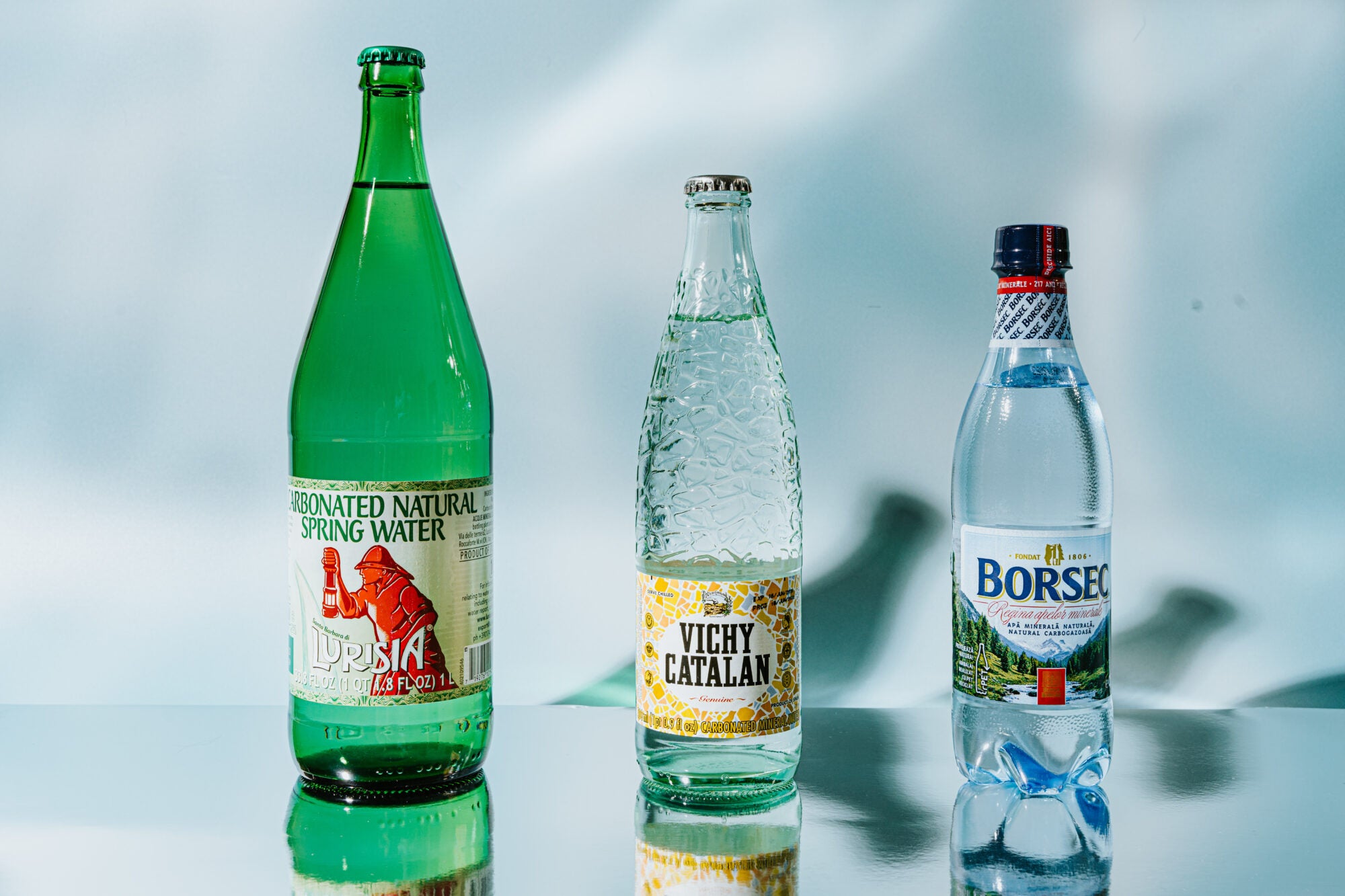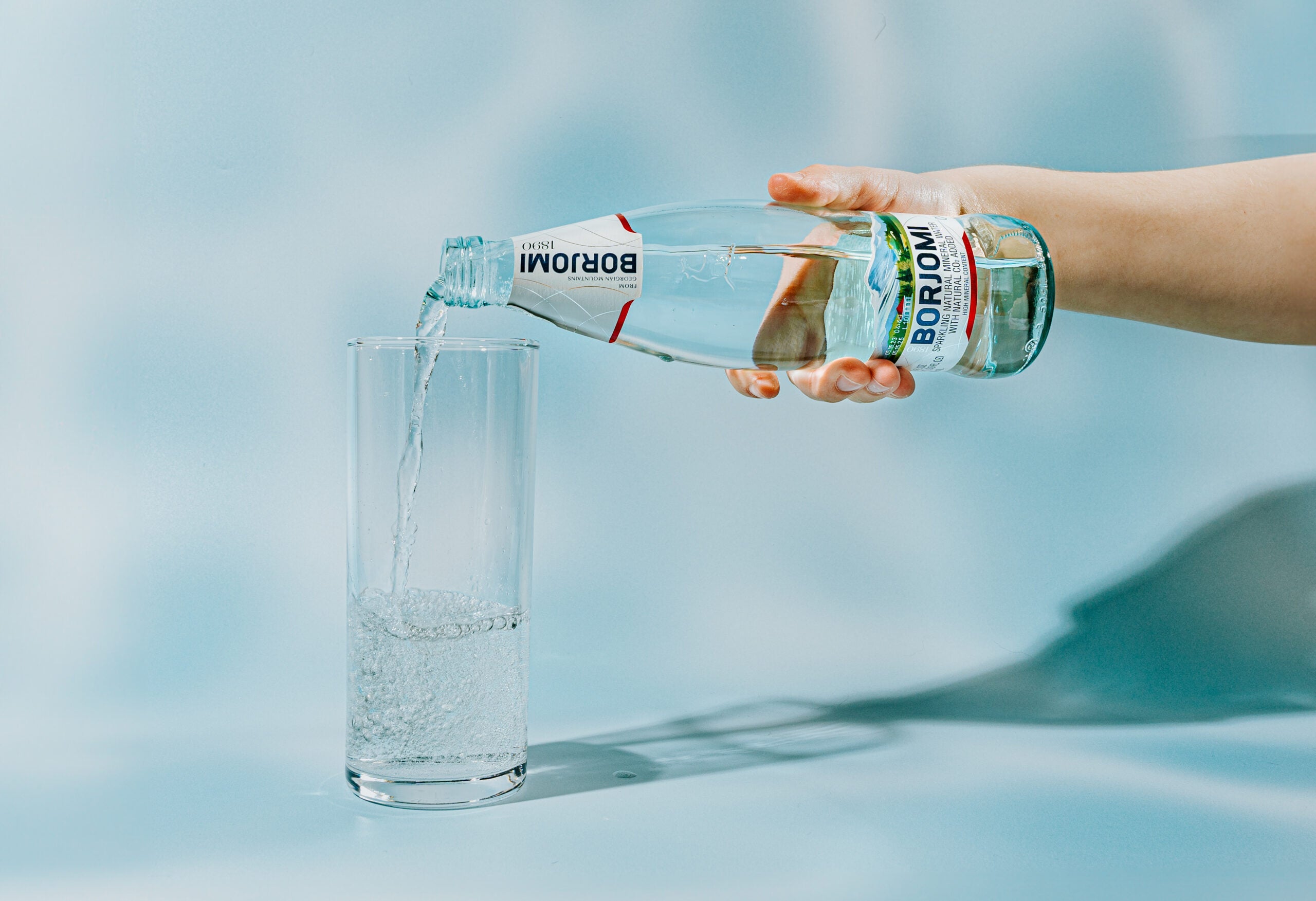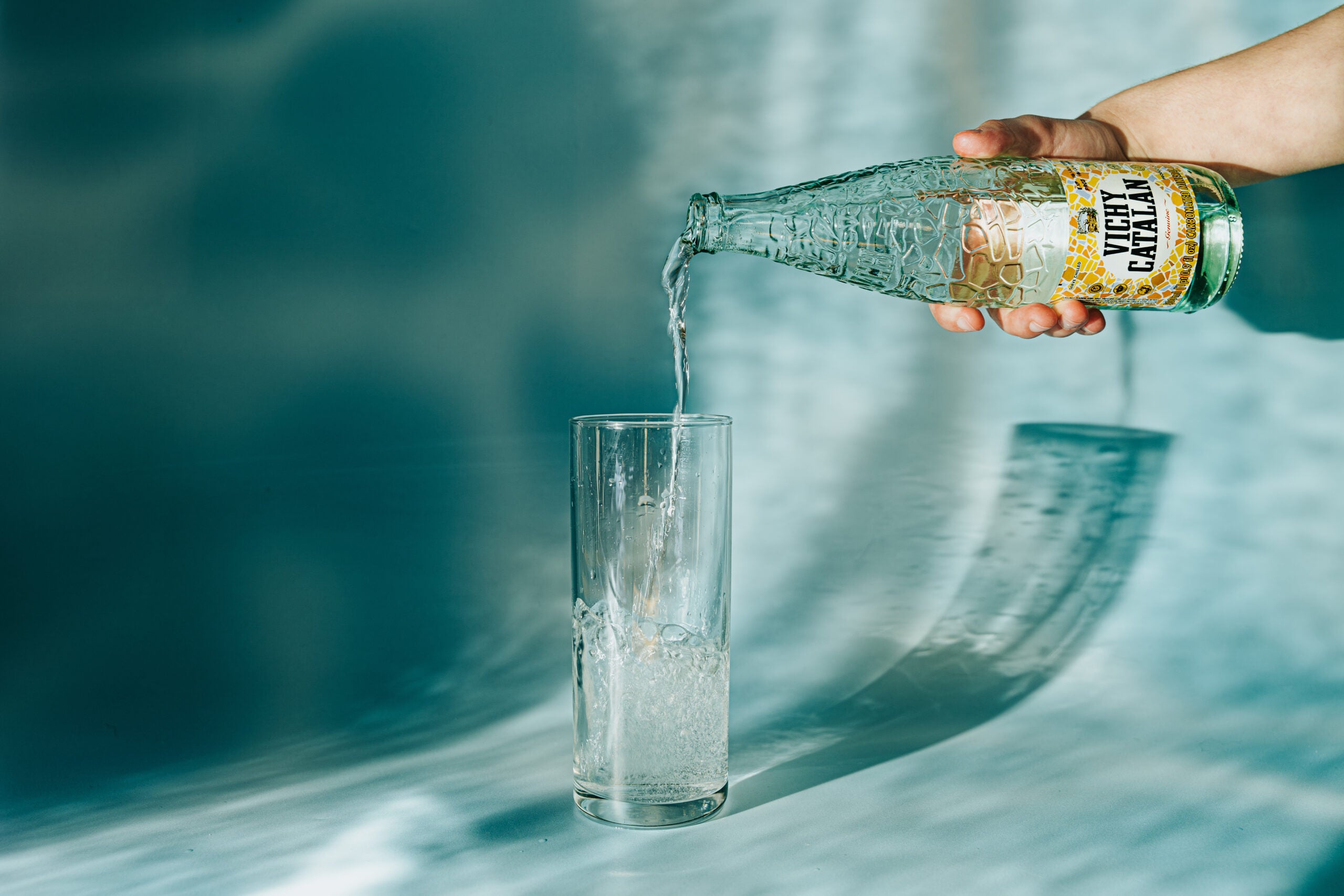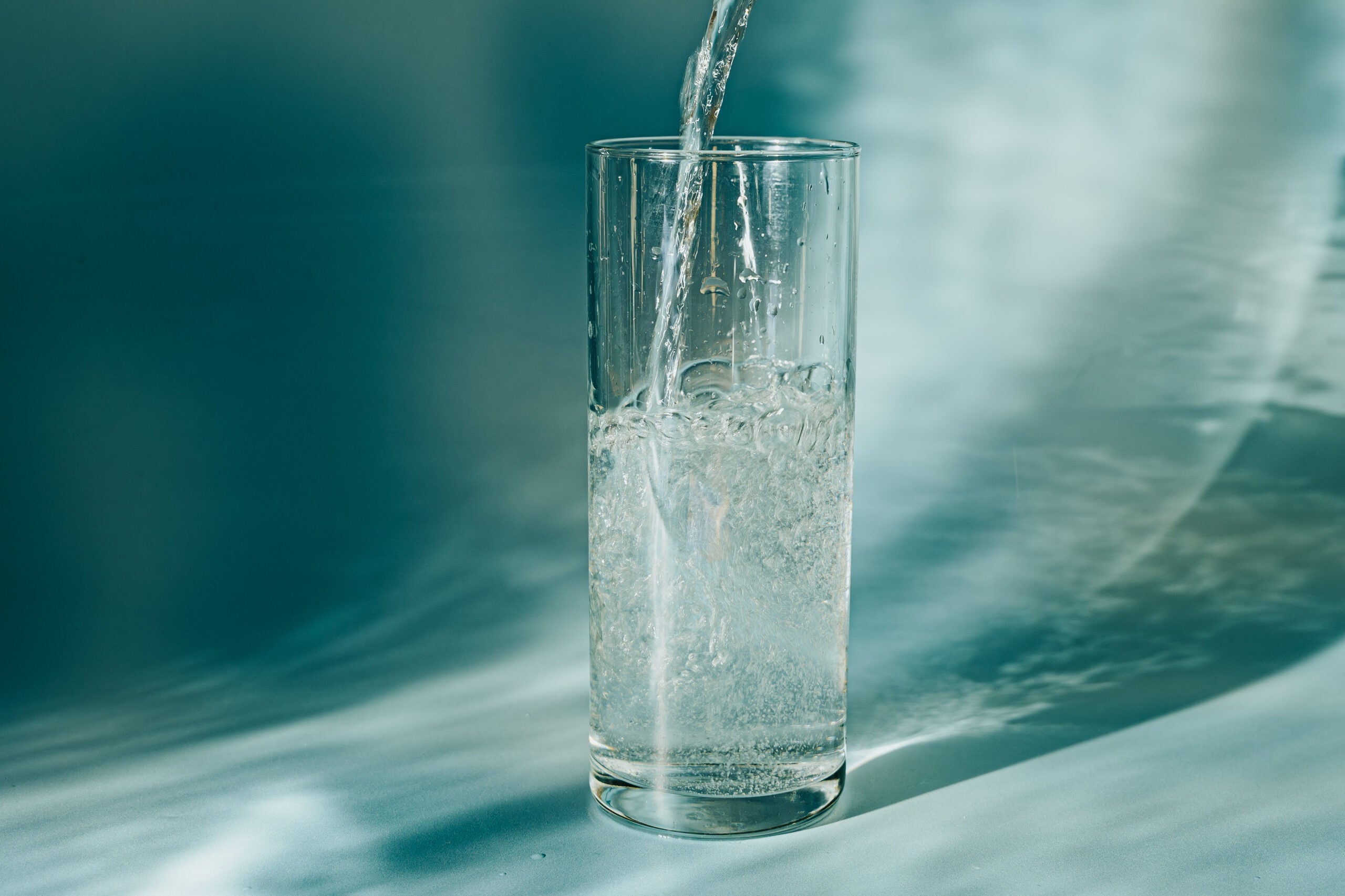
There’s great water, water everywhere, but nobody seems to care. Let’s change that now.
It happened at one of the most exciting restaurants in America, one of those heat-map, hot-list, flame-retardant situations, the kind of place where a cancellation runs $200 a pop and you can hardly get a booking in the first place (I’m only here because it’s my job), in a room full of people bedecked in Our Legacy and Merz b. Schwanen and 3sixteen—real Them Jeans shit—where you notice the tableside bar cart of imported rattan, the elegant sweep of the courteous coursings, the waiter, the back waiter, the sommelier, the sub-sommelier, and, yes, the cavernously minimalist new-build mixed-use dining room itself, almost forebodingly chic, like the Lapland eco-hotel from Ex Machina.
Somewhere toward the middle of the meal—a veritable caloric transit of Venus—betwixt the balletic battement of wines (700 bottles and counting on the list!) and a dozen cocktails and a curated side pairing of de-alcoholized wines and zero-proof cocktails, I found myself (sheepishly!) succumbing to the basest of human thirsts for bonded hydrogen and oxygen. And so I apologized in advance and queried the battalion chief, who fetched the regional assistant to the sub-sommelier, whom I asked if I might please, amongst this literal embarrassment of riches, order a bottle of mineral water.
“Of course! Is Perrier alright?”
It happened again at the chic downtown lunch café/market, the sort of place where you might order the line-caught Oregon tuna salad on spelt levain before choosing from seven kinds of dry cider (local and imported), 35 bottles of wine, three kombucha options, house-made lemon morning buns, and an assorted pectin passel of jams, jellies, and marmalades. Or maybe you’d like a rotisserie gyro with house-fermented Aleppo pepper labneh on lavash, chased with a shot from the $20,000 espresso machine, and just to peruse the takeaway cabinet, collapsing upon itself with Tuscan beans and Campanian pastas and Calabrian chiles and Umbrian olios and Vercellian rices. At checkout, I wondered, you know—since it’s a bit early on a Tuesday for the house Negroni riff with Amalfi gin and fresh bergamot—do they maybe have a bottle of water?
“Yes, but do you mind? It’s Pellegrino.”
Actually, I do mind, and no, it’s not alright!

I openly resent the brutal hegemony with which these two brands dominate the American market for mineral water. The hottest restaurant in town should not be sheepishly selling me the same mineral water you can buy at CVS. The otherwise lovely downtown lunch café’s singular mineral water offering should not be a damn Perrier. It doesn’t make any sense. In an eating-and-drinking milieu so utterly spoiled for choice it has long since overgrown the Petri dish, the conversation around mineral water in America remains helplessly telescoped, myopically hyper-limited, and, worst of all, boring. It reeks of a lack of intention and imagination. It suggests—the horror—substandard curation, which is perhaps the most brutal criticism any millennial can level.
And yet I must level it.
Mineral water is a delicious, vast, exciting drinks category. I’m tired of it being ignored or, worse, fobbed off for the same couple of desultory options you find with disturbing omnipresence from the bodega to the Michelin starred prix fixe. It’s time for this to get fully called out. I’ve really had quite enough.
There are so many wonderful, exciting, culinarily distinct waters from around the world to enjoy and experience: new brands like MTN WTR from Japan or Rambler from Austin, or ancient water sources like Borjomi from Georgia or Borsec from Romania. These are waters with profoundly distinct flavors, textures, and drinking experiences that compound and impact everything else you happen to be eating or drinking in that moment, from the Michelin experience to the casual lunch. And yet they go ignored. It is the great overlook, the missing link, and I am baffled as to why exactly it persists.
I openly resent the brutal hegemony with which these two brands dominate the American market for mineral water.
In 2019—roughly one billion years ago—I wrote what was an, in retrospect, sort of personal essay about mineral water. In the piece, which won a James Beard Award, I argued that mineral water is delicious (it is), that mineral water has lagged behind seltzer in the drinks zeitgeist (it has), and that a generation of Americans was primed to discover the hydrational joys of mineral water as a compliment to every dinner table, a glass nestled helpfully alongside that next great bottle of wine or frozen into ice cubes for a brilliant martini.
And then the damnedest thing happened: nothing. Mineral water did not catch fire in the hearts and minds of American consumers. The landscape for mineral water in America remains almost entirely unchanged five years later. It remains an afterthought, even as we barrel through what some have called “the golden age of zero-proof.” Americans consume 15 billion gallons of bottled water a year, but the vast, vast majority of that is filtered tap water—Dasani, Aquafina, and Glaceau Smartwater are the three most popular bottled waters in the United States. A deeper think about the flavors and textures of different site-specific mineral waters, as evocative and differentiated as wines or coffees, remains wholly elusive, even at the culinary heights of US food and beverage culture, where you are still most certainly—even at the prix-fixiest of prix fixes—going to be served a cursed $12 Pellegrino if you dare to ask for one.
How? Why?
I thought about all this while approaching a deadline that happened to correspond with travel to Europe, first through Schiphol Airport in Amsterdam, then to Florence, and finally culminating in a rousing few nights in London. There were three kinds of bottled water on the KLM trolley and six different waters available at the Amsterdam Airport café. I drank a different kind of bottled water every day for a week in Italy, and the same happened in London. Sourcy, Alisea, San Felice. Uliveto, Filette, Verna, Testi. Tau, Harrogate, Kingsdown, Daylesford. Each one distinctly delicious, hydrating, and interesting, the Sourcy like a free-flowing stream, the Uliveto like a hydrating dirty martini, the Harrogate so finely bubbled and taut.
These are waters that express place and flavor, every bit as beholden to local terroir (or merroir, if you like) as a bottle of wine or piece of cheese. They are extraordinary products and a wonderful compliment to other bits and bobs of food and drink. Never once did someone attempt to serve me a small plastic bottle of Perrier, of which more than one billion are sold each year across 140 countries.
At the risk of sounding like every annoying American who went to Europe once and came home changed, I cannot help but feel like we are profoundly fucking up on this particular matter. Why are we as Americans on such an island—or is it a desert—on the topic of mineral water? To try to uncover the truth, I reached out to a free-flowing source: Martin Riese, “your personal water sommelier.”
I had interviewed Riese as part of my 2019 story, but that was before his multiplatform approach to water education and advocacy really took off. Riese is now, unquestionably, among the biggest water influencers in the world (550,000 followers on TikTok, with another 100,000 or so between Instagram and YouTube), a content creation role he pairs with the task of creating unique and delicious water menus for leading restaurants in Los Angeles, including the Michelin-starred steakhouse Gwen and Lustig, a new modern Austrian cuisine destination in Culver City.

If anyone could speak to the flattening of mineral water culture in America, it’s Riese, and he pulled zero punches when I asked him why this was the case. “It’s money,” he tells me. “Money is why all you see is Perrier and Pellegrino.” These brands are both owned by the same enormously large multinational corporation with well-documented dubious water sustainability practices, and Riese suggests they’re actively buying off food and beverage directors at bars and restaurants across the country, “almost mafioso style.” Riese claims this company offers money to restaurants in exchange for exclusively serving their waters, a practice found elsewhere in the world of soda and coffee. “I’ve even been approached by this company,” Riese says, “and what they do is say, ‘We have our portfolio of still and sparkling, and you’re not allowed to serve anything else, and we’ll give you money.’ And many sommeliers or hospitality directors say yes to that—because who really cares about water anyway?”
Riese does, for starters. “I think it’s appalling to see this at a Michelin-starred restaurant,” he says, his voice quickening with evident upset. “Serving Acqua Panna or Pellegrino in this environment is just ridiculous to me. I can find that water at every petrol station, and this is the experience you are offering?”
I find these claims of monopolistic control just boringly dystopian enough to be plausible. It explains, at least in part, why one keeps seeing the same couple of mineral water options everywhere in the United States, without fail or variation, at restaurants and bars and chic grocerettes that would sooner die than serve you a Nespresso pod, but that are selling you Nestlé waters all the same. To be clear, I am not suggesting that every place in America serving these waters has been actively bought off. It’s more mundane than that. A lot of hospitality directors and sommeliers simply don’t care about water, and so offerings like Perrier and Pellegrino represent a path of least resistance.
If Riese’s social media comments are any indication, many people are entirely uninterested in exploring the wider world of mineral water, and more still find the idea of a “water sommelier” to be patently ridiculous—though many of Riese’s followers are loudly supportive and appreciative. “I have a feeling sometimes that these people are jealous or afraid,” Riese tells me, “because they never thought about the topic of water in any serious way until now. Water has terroir, like wine, and that surprises a lot of people. Not everyone is ready to hear it. A lot of people would rather just serve you Pellegrino with lemon and ice cubes and be done with it.”
Who really cares about water anyway?
For true water believers like Riese—and like me, too, dammit—the result feels something like the old trope of the chef who doesn’t care about coffee or dessert, fobbing off slop that ruins the end of an otherwise lovely meal. Most restaurants hit a wall at some point regarding what they can and cannot care about—it is an infamously brutal business, a fact for which I have respect and sympathy—but the truth is, compared to literally every other facet of food and beverage culture in America, water brands have lagged behind. Educators like Riese are way out on the tip of the spear here; basic education and advocacy continue to be the lodestone of his work, as he is forced to explain, again and again, that “water is not just water.”
Let me be clear: I absolutely do see progress being made, and I think the wider public attitude toward mineral water as a delicacy has changed in some significant ways since 2019. The growth of platform and fandom around someone like Martin Riese is actually a very good example of this, inasmuch as we can trust social media numbers to be an arbiter of truth. “Ten years ago, when I started out offering water menus in Los Angeles, people thought I was absolutely crazy,” he tells me of his earlier work with printed, book-bound water menus at Ray’s and Stark Bar and Petit Ermitage. “Today the attitude is changing. People in the restaurants really love it—they’re learning that different mineral waters have a different taste and texture and can complement food and wine in interesting ways. And so much of the younger generation doesn’t drink [alcohol] in the first place,” he adds. “Ninety-five percent of my followers are younger than me.”
Riese points to social media as a useful tool, and somewhere that education and advocacy for diversity in mineral water experiences can be advocated for outside of the money game deciding what’s served in our bars and restaurants. He points to online communities like “HydroHomies” on Reddit and the wider NA movement as being ready-made for supporting a sea change in how mineral water is viewed in America. “More and more people are ready to learn the truth about water,” Riese says. “It’s the healthiest beverage on the planet, and it has taste and impact.”
And speaking of impact, it’s likely that some readers are wondering about the environmentalism of it all; for reasons both complex and immediate, water gets earmarked for sustainability scrutiny in a way that’s absent from many of the other imported products we consume. Water gets picked on, in part, because it’s the only thing we consume for which there is a “free version” available on demand in almost every American household; this elides the profound differences flavor, texture, and refreshment experience one can have when drinking a mineral water from a site-specific source as opposed to drinking tap. For what’s it’s worth, Riese puts good old-fashioned LA County tap water on all his menus now (filtered, of course), to maintain the helpful distinction he sees between water as a hydrational necessity and water as a culinary experience. Most serious bottled waters, like those mentioned in this article, are available in glass bottles or aluminum cans, and mindful adherence to a recycling program is paramount no matter what can-or-bottled product you happen to enjoy.
The last five years have seen some meaningful brand breakthroughs. The ascendant death-metal-coded brand Liquid Death is the obvious runaway success story—it is now a “billion-dollar beverage brand” with an expanding range of flavored and caffeinated options, so that one may have choices in how to murder one’s thirst. For the first several years of that growth, the water was sourced in the Austrian Alps, but today it’s being sourced from a county in western Virginia (much to the horror of certain members of the aforementioned HydroHomies community).
A product I personally enjoy is called Rambler, a sparkling water company founded in Austin, Texas, in 2019. I first came across this product at an annual chef festival called Hot Luck, which Rambler sponsors; I drank 21 cans of the stuff in three days at last year’s event, a helpful survival mechanism of sorts in the Texas heat, but also a palate refresher between the phalanx of food festival nibbles and bites. Rambler’s approach is interesting: it uses reverse osmosis to create a neutral water product from local taps, then remineralizes it to a specific recipe that yields a creamy mouthfeel and a hydrating blend of potassium, magnesium, and calcium—three minerals that are commonly found in mineral waters around the world. “This mineral stuff used to be a really fringe, geeky conversation for American consumers,” says Rambler cofounder James Moody, “but more and more Americans are becoming hip to it the same way Europeans have always been.”

Rambler’s growth over the last five years has been impressive as well—the brand brought in $8 million in revenue in 2023 and has doubled its revenue each year for the last three—and it’s increasingly available in restaurants, grocery stores (including Erewhon, where all American beverage trends arrive first), and even the holy triumvirate of the Austin dive bar–saloon–honky tonk, where Rambler represents a culturally appropriate and sessionable NA alternative. But Moody tells me the brand’s market identity is less about replacing beer or spirits and more about the collapse of soda consumption. “What we’re really witnessing is the fall of Coke,” he tells me. “It’s an active shift in the market share of soda in America from what we saw in the ’70s, ’80s, and ’90s. People used to proudly drink soda all the time, but nowadays it’s something you’re way less likely to see people doing in bars—it’s become almost like having a cigarette. There’s a cultural shift happening, and that’s where markets are created.”
The growth of brands like this is a good sign, as is the increasing presence at import grocery stores of brands like IZUMI MTN WTR (Japan), Lurisia (Italy), and Vichy Catalan (Spain). Vichy, in particular, when paired with grilled beef, offers one of the most incredible combinations known to man, and has been a staple of Riese’s water menus across Los Angeles over the last decade. My dream is for there to be a massive upswell in interest and customer appreciation for mineral water among American consumers; I cannot keep driving out to the continental market for this stuff once a week (well, actually, I can, but the rhetorical point stands).
But we’re not there yet. Right now, it keeps coming back to the same waters over and over again: Perrier or Pellegrino, both of which are owned by the same enormous company. It’s like being asked “Chicken, or fish?” at the Moose Lodge function, or like being forced to choose between two—and only two—atrocious candidates for president.
Somewhere in the process of writing this, I got a little thirsty.
In my fridge, there happened to be a bottle of Borsec, which is mineral water from Romania, and a bottle of Radenska, which is mineral water from Slovenia. This probably has me marked by most of you reading this as being impossibly, ridiculously effete and fancy, though this is as good a time as any to remind you of the utterly affordable luxury these bottled waters offer in the grand financial scheme of things (Radenska, $3.99; Borsec, $4.99).
The Radenska is a fiery, tightly carbonated water, really beautiful to make highball cocktails with or add drops of bitters, and I like serving it tall in a Tom Collins glass. The Borsec has a much rounder, fuller mouthfeel, with a high level of TDS—total dissolved solids—and some 1,800 milligrams of magnesium per liter (most magnesium supplement tablets have around 50 milligrams), and I like serving it in a Burgundy bowl. Using real stemware with water is another level of fun and makes everything taste better. I know I’m way out on a limb here, but I’m telling you—you there, some 3,000 words into reading this—that the actual makeup of this stuff, the flavors and textures and mineral content of these waters, is nothing short of a goddamn natural miracle. Drink it when you’re hungover, and it’s like God’s own Gatorade. Pair it with food, and it’s as versatile and thought-provoking as any wine or craft ale. I can’t believe this isn’t a more popular thing yet in America. I feel like everyone is missing out.
I could conclude on health or wellness or mindfulness, but really the point to make here is, paradoxically, the utter hedonism of it all. Some of the most delicious, revelrous, indulgent liquids you will ever drink in your too-short life happen to be mineral waters. Yes! Wrap your head around the seeming incongruity. Grok my wavelength. Pick up what I’m putting down. Mineral water is the missing weapon in your life’s rich pageant of flavors and tastes and textures and experiences. It is not some throwaway thing. Go to Europe if you don’t believe me. I want to reach through the screen and shake the lot of you, because I know, even now, that you’re skeptical. Forget buying the world a Coke; I’d like to buy the world a Lurisia.